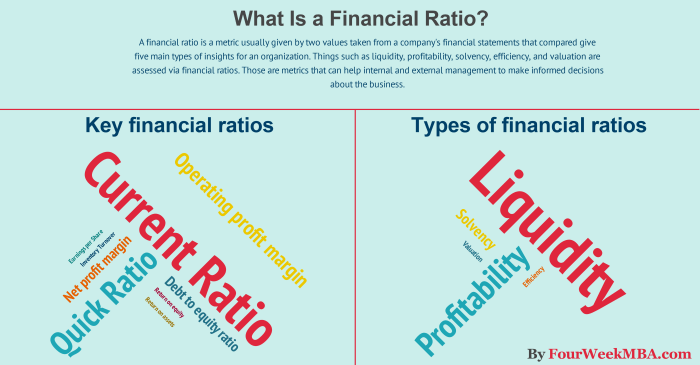Dive into the world of finance with a deep understanding of financial ratios. These powerful tools reveal insights into a company’s performance and financial health, guiding investors and analysts in making informed decisions.
As we explore liquidity, profitability, efficiency, and financial leverage ratios, you’ll gain a comprehensive view of how these metrics impact business operations and investment strategies.
Introduction to Financial Ratios
Financial ratios are essential tools used in financial analysis to evaluate a company’s performance and financial health. By comparing different financial metrics, ratios provide insights into various aspects of a company’s operations, profitability, leverage, efficiency, and liquidity.
Types of Financial Ratios
- Liquidity Ratios: Measure a company’s ability to meet short-term obligations.
- Profitability Ratios: Evaluate a company’s ability to generate profits.
- Debt Ratios: Assess a company’s leverage and ability to handle debt.
- Efficiency Ratios: Measure how effectively a company utilizes its assets and liabilities.
Liquidity Ratios

Liquidity ratios are crucial financial metrics that measure a company’s ability to meet its short-term obligations with its current assets. These ratios provide insight into a company’s liquidity position and financial health, helping investors and stakeholders assess the company’s ability to cover its short-term liabilities.
Current Ratio
The current ratio is a common liquidity ratio that measures a company’s ability to pay off its short-term liabilities with its current assets. It is calculated by dividing current assets by current liabilities. A ratio higher than 1 indicates that a company has enough current assets to cover its current liabilities.
Quick Ratio
The quick ratio, also known as the acid-test ratio, is another important liquidity ratio that measures a company’s ability to meet its short-term liabilities using its most liquid assets. It excludes inventory from current assets, providing a more stringent measure of liquidity. The quick ratio is calculated by subtracting inventory from current assets and then dividing by current liabilities. A ratio of 1 or higher is generally considered healthy.
Liquidity ratios like the current ratio and quick ratio are essential tools for evaluating a company’s short-term financial health. They help investors and creditors assess the company’s ability to meet its short-term obligations and manage its working capital effectively. By analyzing these ratios, stakeholders can make informed decisions about the company’s financial stability and liquidity position.
Profitability Ratios
Profitability ratios are financial metrics used to evaluate a company’s ability to generate profit relative to its revenue, assets, equity, and other financial indicators. These ratios are crucial in measuring a company’s earning capacity and overall financial performance.
Net Profit Margin
The net profit margin is a key profitability ratio that indicates the percentage of revenue that translates into profit after all expenses have been deducted. It is calculated by dividing net income by total revenue and multiplying by 100 to get a percentage. A higher net profit margin signifies efficient cost management and strong revenue generation.
Return on Equity
Return on Equity (ROE) is another important profitability ratio that measures how effectively a company is utilizing its shareholders’ equity to generate profit. It is calculated by dividing net income by shareholders’ equity and multiplying by 100 for a percentage. A higher ROE indicates better profitability and efficient use of equity investments.
Significance of Profitability Ratios
Profitability ratios play a vital role in assessing a company’s success in generating profits and managing expenses. They provide valuable insights into a company’s financial health, operational efficiency, and overall performance. By analyzing profitability ratios, investors, analysts, and stakeholders can make informed decisions regarding investment opportunities and business strategies.
Efficiency Ratios
Efficiency ratios are crucial in analyzing how effectively a company utilizes its assets to generate revenue. By understanding these ratios, investors and stakeholders can gain insights into the operational efficiency of a business and identify potential areas for improvement.
Asset Turnover Ratio
The asset turnover ratio is a key efficiency ratio that measures how effectively a company utilizes its assets to generate sales. It is calculated by dividing the net sales by the average total assets. A higher asset turnover ratio indicates that the company is generating more sales per dollar of assets, which is a positive sign of operational efficiency.
Inventory Turnover Ratio
The inventory turnover ratio is another important efficiency ratio that measures how many times a company sells and replaces its inventory during a specific period. It is calculated by dividing the cost of goods sold by the average inventory. A high inventory turnover ratio suggests that the company is efficiently managing its inventory and not holding excessive stock, which can tie up valuable resources.
Financial Leverage Ratios
Financial leverage ratios play a crucial role in evaluating a company’s debt management. These ratios help investors and analysts assess how effectively a company is using debt to finance its operations and how it can impact the company’s financial health.
Debt-to-Equity Ratio
The debt-to-equity ratio is a financial leverage ratio that compares a company’s total debt to its total equity. It indicates the proportion of debt a company is using to finance its assets relative to the value of shareholders’ equity. A high debt-to-equity ratio may suggest that a company is relying heavily on debt to finance its operations, which can increase financial risk.
Interest Coverage Ratio
The interest coverage ratio is another important financial leverage ratio that measures a company’s ability to cover its interest expenses with its earnings before interest and taxes (EBIT). A higher interest coverage ratio indicates that a company is more capable of meeting its interest obligations from its operating income, reducing the risk of default.
Role in Evaluating Risk
Financial leverage ratios can provide insight into the level of risk associated with a company’s capital structure. A high debt-to-equity ratio or low interest coverage ratio may indicate that a company is at a higher risk of financial distress or default, as it may struggle to meet its debt obligations. On the other hand, a lower debt-to-equity ratio and higher interest coverage ratio generally suggest a more stable financial position.
